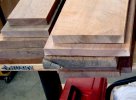Hello,
I am making a nightstand. I am working up some panels for the top / sides, out of white oak. I bought some S2S (top and bottom planed) 4/4 white oak from a good dealer. I've had good luck there in the past.
I'm having the worst time resawing this oak (1", resaw king blade, laguna 14" bandsaw), it keeps pinching my blade, and as soon as the wood is fully sliced through, it springs out into a potato chip. The wood itself is flat and pretty, before I resaw, no evidence of cupping or twist. But as soon as that blade gets through, the 1/2" slices instantly cup.
Did i Just end up with a bad batch or something? I've really never had this problem before.
Any advice?
Jason
I am making a nightstand. I am working up some panels for the top / sides, out of white oak. I bought some S2S (top and bottom planed) 4/4 white oak from a good dealer. I've had good luck there in the past.
I'm having the worst time resawing this oak (1", resaw king blade, laguna 14" bandsaw), it keeps pinching my blade, and as soon as the wood is fully sliced through, it springs out into a potato chip. The wood itself is flat and pretty, before I resaw, no evidence of cupping or twist. But as soon as that blade gets through, the 1/2" slices instantly cup.
Did i Just end up with a bad batch or something? I've really never had this problem before.
Any advice?
Jason

